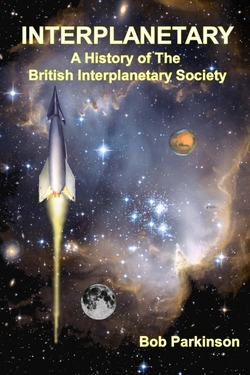Centauri Dreams
Imagining and Planning Interstellar Exploration
The Breakthrough Starshot Opportunity
When we think about what is usually called ‘planetary protection,’ we’re talking about the probes we send to possibly life-bearing places like Mars or Europa. It would confound our investigations if we couldn’t be sure we hadn’t contaminated such a place with microorganisms from Earth, unwittingly carried aboard a lander that was not properly stripped of such passengers. Even our Cassini Saturn orbiter was guided into the planet as a way of ensuring that it would not, at some future date, crash into a place as biologically interesting as Enceladus.
Yesterday, having looked at an essay by Ethan Siegel, I asked rhetorically whether we should think up some kind of exoplanetary protection policy as well. After all, we’re fleshing out an actual mission design through Breakthrough Starshot, aiming to reach nearby stars in coming decades. Siegel (Lewis & Clark College) had expressed his concern that Breakthrough Starshot might inadvertently start an interstellar war. The idea is extreme, but I use the word ‘war’ because it was right there in the title of Siegel’s piece.
What Siegel worries about is that among the large number of payloads Breakthrough Starshot would like to send to nearby stars there might be one that accidentally impacted the planet under study. He’s concerned about the ‘cone of uncertainty’ that would be involved in any trajectory aimed at making a close pass of a planet like Proxima b and argues that at 60,000 km/sec, which is the Starshot goal of 20 percent of c, a tiny 1-gram payload will strike with the force of a 1 tonne asteroid moving at 60 km/sec, a hit like Chelyabinsk.
Harvard’s Avi Loeb, who chairs the Breakthrough Starshot advisory board, finds little merit in the concern. I had been wondering as I wrote yesterday’s post just what Dr. Loeb would have to say about Siegel’s views, only to find an email with a link to his new essay in Forbes in my mailbox shortly after I published — his piece had already appeared that morning. Loeb points out that at a tenth of the speed of light, a payload of Starshot size would “…merely carry the energy of a common asteroid, only a few meters in size — of order the height of a person. Such asteroids hit the Earth a few times per year and burn up in the atmosphere.”
Here is a map of asteroid impacts that Loeb linked to in his essay.
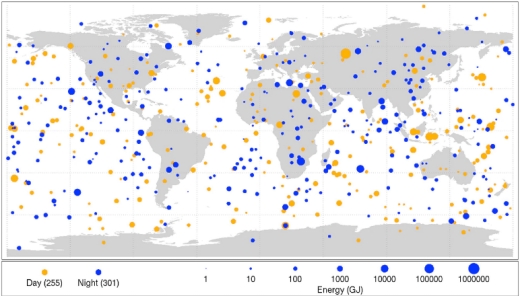
Image: This diagram maps the data gathered from 1994-2013 on small asteroids impacting Earth’s atmosphere to create very bright meteors, technically called “bolides” and commonly referred to as “fireballs”. Sizes of red dots (daytime impacts) and blue dots (nighttime impacts) are proportional to the optical radiated energy of impacts measured in billions of Joules (GJ) of energy, and show the location of impacts from objects about 1 meter (3 feet) to almost 20 meters (60 feet) in size. Credit: Planetary Science.
The map, the work of NASA’s Near Earth Object Program, is instructive. All told, 556 small asteroids impacted our atmosphere in a 20-year period, almost all of them disintegrating in the atmosphere, with the obvious exception of the Chelyabinsk event, which was caused by the largest asteroid to strike in this timeframe. My understanding about Chelyabinsk is that the meteor was approximately 20 meters in size, moving at roughly 19 kilometers per second.
But wouldn’t a one-gram payload moving at Starshot speeds still wreak havoc if it fell on a planetary surface? Evidently the event wouldn’t happen. Let me quote Loeb on this:
…a gram-scale starchip would burn up in the atmosphere of a planet much more easily than a tonne-mass asteroid. Its impact on a planet would be no more irritating than the impact of a dust grain on the skin of a grazing cow. The interplanetary medium is full of debris that poses far greater risks to a planet, as the dinosaurs realized when wiped out by the impact of a 10-15 kilometer asteroid (a trillion times more massive than we just considered) some sixty five million years ago.
In any case, Loeb sees the chances of collision at something less than one part in a million, given the fact that knowing the relative positions of planet and spacecraft over a journey lasting decades is impossible with the payload as envisioned. What Breakthrough Starshot does expect is a closest approach thousands of times larger than the surface of any planet.
We should pause on the deceleration question, which comes up repeatedly whenever I talk about Starshot probes with people new to the project. While it is certainly true that deceleration and orbit in, say, the Proxima Centauri system would be a huge benefit, there is no way to make it happen given the current constraints on the payload, which relies on miniaturization and nonetheless requires vast energies to be brought up to cruising speed. Our initial interstellar efforts will surely be flybys for this reason, and there is a wealth of science that can be gathered.
The other thing to be remembered is that Breakthrough Starshot is an ongoing effort to demonstrate the feasibility of beamed laser sail technologies. Submissions from the first Requests for Proposals are being evaluated as sail stability and materials are considered by way of moving toward experimental work in what we can hope will be a dedicated sail facility. The laser array that would drive these craft presents huge challenges of its own, as do the many other issues, like communications, that will have to be resolved before any interstellar mission can be flown.

We’re looking at an interstellar capability that, if everything were to go well, would still take 30 years to produce a working infrastructure. To those new to Breakthrough Starshot, I recommend looking at the list of technical problems that face the project as it determines whether the concept is sound enough to move to prototype stage enroute to a full deployment. This is going to take time, and we won’t know for quite a while whether the Starshot concept, as is, is workable.
What we do already know is that the commitment of resources underlying the project is already paying off, and will continue to pay off, in the form of newly funded research.
Anyone familiar with the history of interstellar flight studies will know how rare it is to have this level of cooperation and participation among the scientists best equipped to tackle the problem. For most of the past century, researchers interested in the interstellar conundrum did their work in their spare time and met only at the occasional conference, with infrequent journal articles maintaining the thread. The research Breakthrough Starshot will produce will thus be a solid advance for the entire field, no matter if, when or how often the actual missions are flown.

On the Enigma of Arrival
The death of V.S. Naipaul (1932-2018), that cross-grained and all too combative man who saw so unflinchingly into the post-colonial lands from which he drew his heritage, invariably brings to mind his strangest novel, The Enigma of Arrival (Vintage Books, 1987). Temporarily settled into a cottage in Wiltshire in rural England, the author looks back on his career in search of a renewal as cyclic as the seasons. Landscape inspires creativity in this deeply visualized microcosm, even as Naipaul broods over the painting that gives the book its title.
The novel is an odd, self-indulgent work, one I completed more out of a sense of duty (I was reviewing it for a newspaper) than enthusiasm. Yet its introspective imagery keeps resonating. Naipaul was obsessed with the sub-story of the painting, showing the arrival of a visitor at a strange port city and implying a subsequent journey that would in some way parallel his own career.
The work of Giorgio de Chirico (1888-1978), ‘The Enigma of Arrival and the Afternoon’ is a canvas showing this surreal cityscape, a world fitting into Naipaul’s autobiographical meditation with its characters disembarked in a place suggestive of antiquity under a brooding Levantine sky.
A classical scene, Mediterranean, ancient-Roman — or so I saw it [writes Naipaul]. A wharf; in the background, beyond walls and gateways (like cutouts), there is the top of the mast of an antique vessel; on an otherwise deserted street in the foreground there are two figures, both muffled, one perhaps the person who has arrived, the other perhaps a native of the port. The scene is of desolation and mystery…

Which gets us to interstellar flight and other, more exotic arrivals. I’ve always believed that if we ever do discover hard evidence of an extraterrestrial civilization, that experience will not translate into trade opportunities or galactic encyclopedias but mysteries that leave us in some ways more baffled about the nature of intelligence than ever before. I draw a distinction here between ‘contact’ and ‘encounter,’ which are entirely different things, and wonder what this kind of arrival would look like to humans finding evidence for extraterrestrial intelligence.
Here I’ll invoke the splendid novel Roadside Picnic, by Arkady and Boris Strugatsky (1971). Alien artifacts appear at various places on Earth, so-called ‘zones of visitation’ filled with bizarre items, many of them dangerous, and inexplicable happenings. Unseen themselves, the aliens are glimpsed only through what they leave behind in our region of spacetime before moving on. Protagonist “Red” Schuhart is a ‘stalker,’ one who defies the danger to enter the alien zones in search of artifacts. What happens in a Zone can never be predicted.
He had never experienced anything like this before outside the Zone. And it had happened in the Zone only two or three times. It was as though he were in a different world. A million odors cascaded in on him at once—sharp, sweet, metallic, gentle, dangerous ones, as crude as cobblestones, as delicate and complex as watch mechanisms, as huge as a house and as tiny as a dust particle. The air became hard, it developed edges, surfaces, and corners, like space was filled with huge, stiff balloons, slippery pyramids, gigantic prickly crystals, and he had to push his way through it all, making his way in a dream through a junk store stuffed with ancient ugly furniture … It lasted a second. He opened his eyes, and everything was gone. It hadn’t been a different world—it was this world turning a new, unknown side to him. This side was revealed to him for a second and then disappeared, before he had time to figure it out.
Ursula Le Guin was quick to note the connection between the Strugatskys and the work of Stanislaw Lem, the great Polish novelist whose Solaris (1961) is widely admired and twice filmed. Here too, coping with a planet-wide ocean with its own kind of sentience, the human characters come up hard against their own preconceptions and the failure of their paradigms to understand an alien presence. Lem chided what he called ‘the myth of our cognitive universalism,’ a myth the Strugatsky’s equally exploit in the ravishingly strange Roadside Picnic. Like Naipaul, Lem has his own obsession with arrivals.
“We don’t want to conquer the cosmos, we simply want to extend the boundaries of Earth to the frontiers of the cosmos… We are searching for an ideal image of our own world: we go in quest of a planet, a civilization superior to our own but developed on the basis of a prototype of our primeval past. At the same time, there is something inside us which we don’t like to face up to, from which we try to protect ourselves, but which nevertheless remains, since we don’t leave Earth in a state of primal innocence. We arrive here as we are in reality, and when the page is turned and that reality is revealed to us – that part of our reality which we would prefer to pass over in silence – then we don’t like it anymore.”
Is an arrival always a wakening of self-knowledge? Here I might also mention Arthur C. Clarke’s Rendezvous with Rama (1973), in which an alien starship passes through the Solar System, an approach that reminded many Centauri Dreams readers of the recent appearance of ‘Oumuamua. A survey vessel despatched to study the object called Rama discovers geometric structures and a ‘cylindrical sea,’ along with an atmosphere that turns out to be breathable. But Rama will not tarry. After a gravitational slingshot maneuver, it departs the Solar System for the Magellanics.
It is an arrival wrapped in mystery but, as Clarke goes on, “at least we have answered one ancient question. We are not alone. The stars will never again be the same to us.”
Could anything ever be the same? In tales like these, we confront the unknowable in disturbing ways, conflicted by our inability to establish the kind of contact that would explain and enlarge our own existence. No one can know what an actual alien contact might involve, but I suspect that dealing with an entirely separate lifeform deriving from an evolution under wholly different skies will prove to be as enigmatic as anything written by the Strugatskys, Lem or Clarke.
Arrival as Threat?
In that vein, I recently ran across an essay by astrophysicist Ethan Siegel, sent on by several readers who knew how often we’ve discussed Breakthrough Starshot in these pages. What Siegel does is to reverse the story. He wonders how the recipients of an arrival from Earth would react, and speculates that if we’re not careful, we may send entirely the wrong signal.
Breakthrough Starshot, after all, envisions pushing a fleet of small sails carrying payloads of a gram or so to a nearby stellar system. Right now the obvious target is Proxima Centauri, where we know we have a planet in the habitable zone, but we may find equally promising possibilities around Centauri A or B. The goal here is not contact but simply the opportunity to perform flybys of an interesting planet and return data and imagery, and Siegel is quick to note that sails boosted to 20 percent of lightspeed have no deceleration mechanism available to them.
The problem: A ‘cone of uncertainty’ exists for any trajectory that will take us close enough to the planet to retrieve good data, an aiming problem requiring unprecedented levels of precision. Thus the possibility that we could be entering an inhabited stellar system and colliding with a living world cannot be ruled out. Siegel notes the invariable relationship between kinetic energy and speed: Double the speed and you get four times the energy. Even our tiny 1-gram spacecraft moving at 60,000 km/sec, says Siegel, will hit with the force of a 1 tonne asteroid moving at 60 km/sec, which in effect means we could cause a Chelyabinsk-like event, or more than one.
If you were an alien on this world that got struck by these relativistic masses, what would you conclude? You’d know that these were too massive and too fast-moving to be created naturally; they were made by an intelligent civilization. You’d know that you were being intentionally targeted; space is too vast for these to strike you by random chance. And?—?worst of all?—?you’d assume this civilization had a malicious intent. No benevolent aliens would launch something so recklessly and carelessly given the damage it would cause. If we’re smart enough to send a spacecraft across the galaxy to another star, surely we can be wise enough to reckon the disastrous consequences of doing so.
What an arrival this would be. And yet, in order to study nearby worlds, we have yet to come up with a plan remotely as feasible as the admittedly longshot Breakthrough Starshot. Are there ways we can minimize this risk or eliminate it altogether while still finding a way to begin interstellar explorations? Because we do need to consider how we are perceived when we probe into the utterly unknown, and if the odds seem long that there is a civilization on Proxima b or that we might inadvertently hit the planet we are studying, they are still not zero.
The enigma of arrival is magnified and transformed when we are arriving at a place we are seeing for the first time, just as our arrival at Pluto/Charon opened up two worlds while posing new mysteries about the surfaces we flew past. Naipaul referred to de Chirico’s scene as the depiction of ‘a dangerous classical city,’ one in which the newcomer sought orientation and meaning. How much more enigmatic might our own arrival be if perceived by other intelligences? Should the need for ‘exoplanetary protection’ join our other mission parameters?
[Addendum]: Be sure to look at Avi Loeb’s spirited response to Siegel in Why Humanity Probably Won’t Accidentally Start An Interstellar War With An Alien Civilization. More on this tomorrow.

Omega Centauri: Improbable Venue for Life?
Although it appears in the same constellation as seen from Earth (Centaurus), Omega Centauri has nothing to do with the Alpha Centauri stars that so interest interstellar flight theorists. The brightest globular cluster visible in our skies, Omega Centauri is anything but close (16,000 light years out) and, containing several million stars, is the largest globular cluster in our galaxy. We may in fact be looking at the core of a dwarf galaxy once absorbed by the Milky Way.
But although it’s quite distant, Omega Centauri may be the source of the relatively nearby Kapteyn’s Star, just 13 light years from the Sun. Where this gets intriguing is that Kapteyn’s Star, (named after Dutch astronomer Jacobus Kapteyn) is known to have at least two planets, one of them considered the oldest known potentially habitable planet — let’s call it a ‘temperate Super-Earth’, as Guillem Anglada-Escudé and team have done — at 11 billion years old.
Steven Kane (UC-Riverside), working with graduate student Sarah Deveny (San Francisco State) has now produced a paper taking a deep dive into Omega Centauri and its own prospects for habitability. Beginning with 470,000 stars in the cluster’s core, the duo focused on a subset of 350,000 of these, using color as a gauge of temperature and age in making their choice. The idea was to calculate habitable zones around each star, in which a rocky world might have liquid water on the surface.
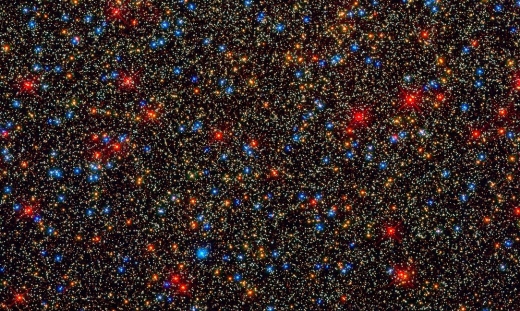
Image: There are colorful stars galore, but likely no habitable planets, inside the globular star cluster Omega Centauri. Credit: NASA, ESA, AND THE HUBBLE SM4 ERO TEAM.
The paper Kane and Deveny produced makes the point that most exoplanet searches have occurred around field stars, but globular clusters are attractive hunting grounds given the age of their stars and the possibility they offer to study planet formation and evolution as affected by the cluster. But so far planet hunting in such clusters has not proven profitable. A 2000 study using the Hubble instrument to study 34,000 stars in the core of the cluster 47 Tucanae revealed not a single transit, nor did follow-ups in the less crowded outer regions of the cluster.
Nor have transiting planets been found in the cluster NGC 6397. Undaunted, Kane and Deveny here analyze Hubble data on the core of Omega Centauri and calculate habitable zones for the observed stars. The idea is to determine how conditions in the Omega Centauri core affect the potential habitability of planets around main sequence stars, the latter being determined by a color-magnitude diagram with data drawn from filters described in the paper. Luminosity and effective temperatures were calculated using Hubble instrument filters from the Dartmouth Stellar Evolution Database, assuming 11.5 billion years as the age in the applied model.
Kane and Deveny use habitable zone relationships and methodologies found in the literature, going on to calculate the conservative habitable zone (CHZ) and optimistic habitable zone (OHZ), boundaries that Kane previously used in creating a catalog of Kepler habitable zone planets. Given the star properties determined by the above analysis, which showed that the sample under consideration was dominated by low-mass stars, the researchers found that about 50 percent of the sample had an outermost habitable zone boundary within 0.5 AU of the star.
No surprise there, as most of the stars in the Omega Centauri core are red dwarfs, implying habitable zones much closer than those around G- and K-class stars. Compact planetary systems of the kind we see, for example, around small M-dwarfs like TRAPPIST-1 would seem to stand a better chance of survival from disruption by nearby stars, but conditions here are truly tight. Our Sun has a separation of over 4 light years from its nearest stellar neighbors, but within Omega Centauri’s core, the average distance is a scant 0.16 light years. That would set up frequent encounters between stars, on the order of one every 1 million years.
The result does not bode well for these planets, as the paper notes:
…the compact nature of the HZ regions is more than offset by the potential disruption of planetary systems, where close encounters of only 0.5 AU are expected to occur on average every 1.65 × 106 years. Though the large resulting population of free-floating terrestrial planets are intrinsically interesting from formation and dynamical points of view, the potential for habitability in the ω Cen core environment is significantly reduced by such scattering events. The primary lesson that can be extracted from this analysis is the underlining of the importance of quantifying the long-term dynamical stability of orbits inside HZ regions taking into account both internal (planetary) dynamics and external (stellar) interactions.
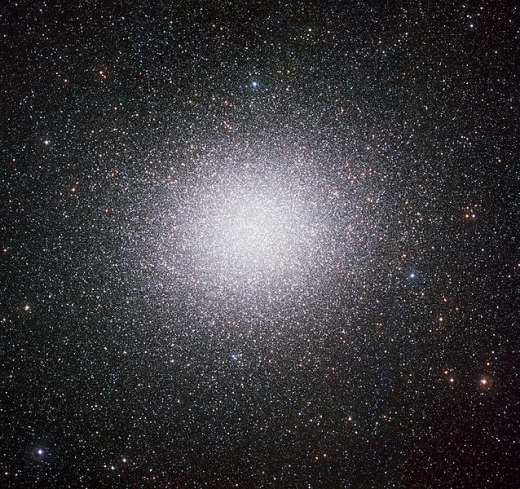
Image: The globular cluster Omega Centauri — with as many as ten million stars — is seen in all its splendor in this image captured with the WFI camera from ESO’s La Silla Observatory. The image shows only the central part of the cluster — about the size of the full moon on the sky (half a degree). North is up, East is to the left. This colour image is a composite of B, V and I filtered images. Note that because WFI is equipped with a mosaic detector, there are two small gaps in the image which were filled with lower quality data from the Digitized Sky Survey. Credit: ESO.
Because we have no firm knowledge of how common planets are in this environment, we’re left to speculate, but the paper’s calculations show that numerous compact planetary systems could exist in Omega Centauri. But even assuming a large population of rocky worlds, cluster dynamics would keep encounters between these planetary systems happening on a regular basis. The scenario of planets stripped from their host stars seems inimical to life.
But a possibility remains. Terrestrial-class worlds disrupted from their home systems could constitute a large population of free-floating worlds that might be analyzed through gravitational microlensing. There are some studies in the literature arguing that free-floating worlds with a thick hydrogen atmosphere could retain habitable conditions at the surface, so as the authors note, habitable planets cannot be entirely ruled out despite the problem of stability.
And, of course, encounter rates between stars will vary depending on the size and density of the cluster:
“The rate at which stars gravitationally interact with each other would be too high to harbor stable habitable planets,” Deveny said. “Looking at clusters with similar or higher encounter rates to Omega Centauri’s could lead to the same conclusion. So, studying globular clusters with lower encounter rates might lead to a higher probability of finding stable habitable planets.”
Such studies will doubtless be pursued. After all, the close separation among ancient stars at a globular cluster’s core would seem to give any civilizations that formed near them the opportunity to explore nearby systems and eventually the entire cluster. We’ve talked before about the work of Rosanne Di Stefano (Harvard-Smithsonian Center for Astrophysics), who makes this case (see Globular Clusters: Home to Intelligent Life?). Says Di Stefano:
“Interstellar travel would take less time… The Voyager probes are 100 billion miles from Earth, or one-tenth as far as it would take to reach the closest star if we lived in a globular cluster. That means sending an interstellar probe is something a civilization at our technological level could do in a globular cluster.”
In fact, Di Stefano argues that portions of many globular clusters other than the core can be considered ‘sweet spots’ where habitable orbits are stable for long periods. So the question of habitability and planet formation itself inside globular clusters is one of continuing interest.
One thing is clear. When we talk about habitable zones, we have to take into account the dynamical stability of the orbits involved, examining not just the planets themselves but the possibility of encounters with nearby stars. In dense environments, such interactions and the scattering they cause would be game-changers. Cluster outskirts may offer better opportunities.
The paper is Kane and Deveny, “Habitability in the Omega Centauri Cluster,” accepted at The Astrophysical Journal (preprint). The Di Stefano paper mentioned above is “Globular Clusters as Cradles of Life and Advanced Civilizations,” Astrophysical Journal Vol. 827, No. 1 (5 August 2016). Abstract.

Probing Ultrahot Jupiters
Speaking of getting really, really close to a star, as we were yesterday in our discussion of the Parker Solar Probe, I couldn’t help but turn to new computer models of the ‘ultrahot Jupiter’ WASP-121b. I still find it delightful that the earliest exoplanet detections involved a category of planet that few scientists had imagined existed. These days we routinely discuss gas giants blisteringly close to their hosts, and even manage to extract information about their atmospheres through transmission spectroscopy, but few people expected such planets when we began to discover them.
In fact, Apollo 11’s Buzz Aldrin had a role to play in what may be considered to be the first prediction of the worlds we would start calling ‘hot Jupiters.’ Working with John Barnes on his novel Encounter with Tiber (Grand Central, 1996), Aldrin asked physicist Greg Matloff whether a hydrogen-helium atmosphere as found in a Jupiter-class world could survive in an inner stellar system. Here’s how Matloff recalls the discussion:
Although I was initially very skeptical since then-standard models of solar system formation seemed to rule out such a possibility, I searched through the literature and located the appropriate equation (Jastrow and Rasool, 1965)….To my amazement, Buzz was correct. The planet’s atmosphere is stable for billions of years. Since I was at the time working as a consultant and adjunct professor, I did not challenge the existing physical paradigm by submitting my results to a mainstream journal. Since “Hot Jupiters” were discovered shortly before the novel was published, I am now credited with predicting the existence of such worlds.
Indeed, for this was just at the time when 51 Pegasi b swam into our consciousness in 1995 (the book was finished but not yet published when the discovery was made). Now we knew that hot Jupiters were out there, and the radial velocity method of exoplanet discovery ensured that large planets close to their star would be the most likely to be detected in our earliest efforts.
The Realm of the ‘Ultrahot’
But hot Jupiters are but one variety of inner system gas giants. Today we can catalog a planet like WASP-121b as a member of a still more unique class of worlds, distinguishing between ‘hot Jupiters’ and those gas giants that come astoundingly close to their stars.
Dubbed ‘ultrahot Jupiters,’ these worlds reflect about as much light as charcoal. What distinguishes them is a temperature that on the dayside causes them to glow like an ember. Thus the image below, in which WASP-121b is simulated based on computer models that draw on observations of the planet conducted by the Spitzer and Hubble space instruments.
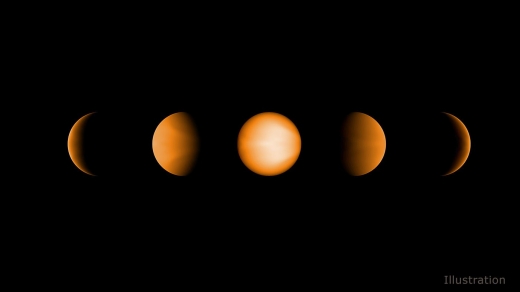
Image: These simulated views of the ultrahot Jupiter WASP-121b show what the planet might look like to the human eye from five different vantage points, illuminated to different degrees by its parent star. The images were created using a computer simulation being used to help scientists understand the atmospheres of these ultra-hot planets. Credit: NASA/JPL-Caltech/Aix-Marseille University (AMU).
The word ‘hellish,’ so often used to describe the surface of Venus, can with even more justice be applied to ultrahot worlds like this. They orbit closer to their host stars than Mercury does to the Sun, tidally locked and with temperatures that can range between 2,000 and 3,000 degrees Celsius. Even the nightside of such a world can reach 1,000 degrees Celsius, though as we’ll see, this makes enough of a difference to explain some anomalous observations.
For new work from Vivien Parmentier (Aix Marseille University, France) and colleagues goes into the question of why we find no water vapor in the atmospheres of these worlds. Hot Jupiters — gas giants in an inner system that experience dayside temperatures below 2,000 degrees Celsius — have been found with abundant water vapor in their atmospheres. But ultrahot Jupiters seem to lack it. One theory on why is that these planets formed with high levels of carbon instead of oxygen, but the new study points to the occasional traces of water that have been detected at the dayside-nightside boundary as a refutation of the idea.
Parmentier’s team, applying a model of brown dwarf atmospheres developed by co-author Mark Marley (NASA Ames), went to work on ultrahot Jupiter atmospheres as if they were the atmospheres of stars. After all, says Parmentier, “The daysides of these worlds are furnaces that look more like a stellar atmosphere than a planetary atmosphere. In this way, ultrahot Jupiters stretch out what we think planets should look like.”
The team used Spitzer observations of WASP-121b at infrared wavelengths to probe carbon monoxide levels in its atmosphere. CO molecules have a bond strong enough to withstand the dayside heat. The result: The planet’s atmosphere reveals a strong temperature gradient, burning hotter higher up than further down. A uniform atmosphere could have masked the signature of water molecules, providing one explanation for the apparent lack of water.
But the carbon monoxide work showed that the answer lies elsewhere. According to the study, hydrogen and oxygen atoms are indeed found on ultrahot Jupiters, but the strong irradiation on the dayside simply tears the water molecules apart. The researchers have placed WASP-121b in the context of recently published studies authored by Parmentier, co-author Michael Line (ASU) and others on fellow ultrahot Jupiters WASP-103b, WASP-18b and HAT-P-7b.
They have concluded that the fierce stellar winds of the dayside blow the broken water molecules onto the nightside, where they can recombine and condense into clouds before, inevitably, drifting back onto the dayside to undergo the destructive process again.
The paper sees the transmission spectrum of WASP-121b as being consistent with a solar composition atmosphere having partial cloud coverage. Within its dayside atmosphere, molecules are being continually sundered. And here is why we see no water:
Ultra hot Jupiters with dayside temperatures larger than 2200K are good targets for thermal emission measurements. However, the majority of the observed planets have weaker-than-expected spectral features in the 1?2µm range. Using the example of WASP-121b, we interpret this lack of strong features as being due to a combination of a vertical gradient in molecular abundances due to thermal dissociation, and to the presence of H? [the hydrogen anion, or negative ion of hydrogen] absorption at wavelengths shorter than 1.4µm.
Thermal dissociation affects all spectrally important molecules in the atmospheres of ultra hot Jupiters except CO. It creates a large vertical gradient in the molecular abundances. We show analytically that the presence of such a molecular gradient weakens the features in emission spectra. This is a qualitatively different effect than a global depletion of the abundances.
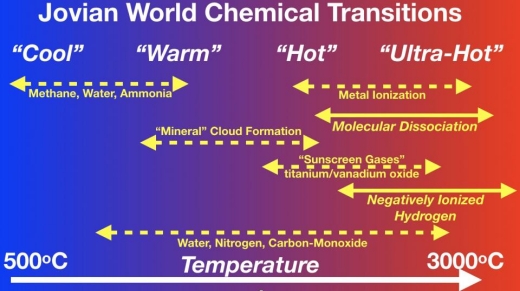
Image: Jupiter-like exoplanets are 99 percent molecular hydrogen and helium with smaller amounts of water and other molecules. But what their spectra show depends strongly on temperature. Warm-to-hot planets form clouds of minerals, while hotter planets make starlight-absorbing molecules of titanium oxide. Yet to understand ultrahot Jupiter spectra, the research team had to turn to processes more commonly found in stars. Credit: Michael Line/ASU.
What a place an ultrahot Jupiter must be. The idea of this kind of circulation in the atmosphere is given force by the previous detection by Hubble of clouds at the boundary between night and day. The same process may affect titanium oxide as well as aluminum oxide. Because the latter is the basis for the gemstone ruby, this JPL news release speculates that there could be clouds producing rains of liquid metals and fluidic rubies in the atmospheres of ultrahot Jupiters. That would make the ultrahot Jupiter about as exotic an environment as we can conceive.
The paper is Parmentier et al., “From thermal dissociation to condensation in the atmospheres of ultra hot Jupiters: WASP-121b in context.” submitted to Astronomy & Astrophysics (preprint).

Musings on the Parker Solar Probe
The first thing I did when I heard about the Parker Solar Probe’s successful launch (0731 UTC Sunday) was to double-check the spacecraft’s projected velocity when it makes its closest approach to the Sun. I always think in terms of high speed when contemplating operations close to our star, the legacy of the two Helios missions, which at present hold the record as fastest man-made objects. Placed in highly elliptical orbits after their launches in 1974 and 1976, the Helios spacecraft managed a sizzling 70 kilometers per second.
The Helios missions were a joint venture between what was then West Germany’s space agency and NASA, the craft themselves built by German aerospace firm Messerschmitt-Bölkow-Blohm. Helios 2 flew closer to the Sun by about 3 million kilometers, closing to 0.29 AU (43 million kilometers), which took it inside the orbit of Mercury. The Parker Solar Probe ups the ante considerably, with an eventual closest approach of just 6.1 million kilometers.
The spacecraft at that point will be moving at roughly 192 kilometers per second, easily eclipsing the Helios record. Now imagine if we could put a spacecraft at these speeds on a course for Alpha Centauri. Context is everything, and what is truly a blistering pace in comparison to our previous records turns out to be a good deal less than 1 tenth of one percent of lightspeed when pondered in interstellar terms. It gets us to Centauri A/B in 6000 years.
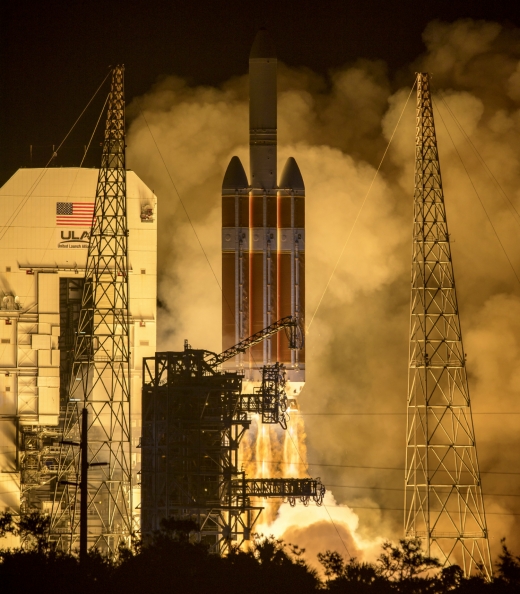
Image: The United Launch Alliance Delta IV Heavy rocket launches NASA’s Parker Solar Probe to touch the Sun, Sunday, Aug. 12, 2018, from Launch Complex 37 at Cape Canaveral Air Force Station, Florida. Parker Solar Probe is humanity’s first-ever mission into a part of the Sun’s atmosphere called the corona. Here it will directly explore solar processes that are key to understanding and forecasting space weather events that can impact life on Earth. Credit: NASA/Bill Ingalls.
We’ll track the Parker Solar Probe with great interest over the course of its seven year mission, which gets interesting quickly as the craft heads toward Venus for the first of seven flybys of that planet, using Venus’ gravity to tighten up its solar orbit. By November, the Parker Solar Probe will be positioned to pass through the Sun’s corona with the first of its projected 24 total passes by the Sun. Bear in mind that the corona is more than 300 times hotter than the Sun’s surface.
We have an 11-centimeter thick carbon-carbon composite shield to thank for making operations in this environment possible, one whose front surface is capable of withstanding temperatures beyond 1300 degrees Celsius. This advanced thermal protection will keep four suites of instruments alive to study plasma and energetic particles, magnetic fields and the solar wind.
That last point has great relevance to our discussions on Centauri Dreams, namely the methods we may one day use for fast transportation around the Solar System by way of building the infrastructure we’ll need for interstellar flight. The more we learn about the solar wind, which can hit 800 kilometers per second, the more we’ll understand the variables that may help us harness it through variously designed magnetic sails. That assumes, of course, that this highly mutable and unpredictable flow is manageable enough to navigate with such craft.
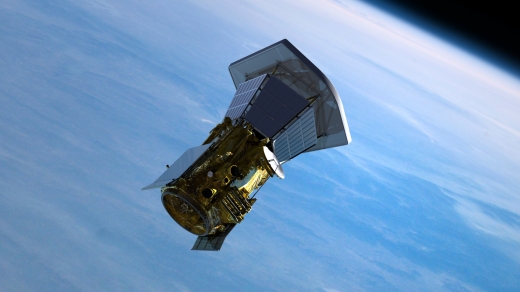
Image: Artist’s impression of the Parker Solar Probe spacecraft leaving Earth, after separating from its launch vehicle and booster rocket, bound for the inner solar system and an unprecedented study of the Sun. Credit: JHU/APL.
I’ve commented before in these pages that there are also interesting implications for future ‘sundiver’ missions in the Parker Solar Probe. In these concepts, a solar sail, perhaps furled behind an occulter such as a small asteroid, would be taken as close as possible to the Sun before being unfurled at perihelion to achieve the highest possible acceleration. If a mission like that is ever to happen, we’ll need the kind of data the Parker Solar Probe delivers as we learn how to operate in an environment as extreme as any spacecraft has ever encountered.
The Parker Solar Probe’s solar arrays have already deployed. Immediately ahead for the spacecraft is deployment of its high-gain antenna and magnetometer boom, as well as the first of a two-part deployment of its electric field antennas. The instrument testing period begins in early September and continues for four weeks, after which science operations will begin.

Detecting Life On Other Worlds
Now that we’re getting closer to analyzing the atmospheres of terrestrial-size exoplanets, it’s worth remembering how difficult the call on the existence of life is going to be. Long-time Centauri Dreams contributor Alex Tolley takes on the issue in his essay for today, pointing out along the way just how easy it is to see what we want to see in our data. While we can learn much from terrestrial biology, new approaches looking at ‘pathway complexity’ may offer useful indications of biology and a set of markers not constrained by our own unique sample of life on Earth. A lecturer in biology at the University of California, Alex brings us up to speed with extending our methods of life detection in ways that are ‘biology agnostic.’ Expect controversy ahead — will we know life when we see it, and how can we be sure?
by Alex Tolley

Manuel Werner, CC BY-SA 2.5, https://commons.wikimedia.org/w/index.php?curid=633977
Life: [noun]? The condition that distinguishes animals and plants from inorganic matter, including the capacity for growth, reproduction, functional activity, and continual change preceding death. – Oxford Living Dictionary [6]
Life, like pornography, is notoriously hard to define, but we mostly recognize it when we see it. Life, as we know it, is identified by a set of features, which individually, may be shown by non-living systems. A classic example is “fire”, that can exhibit a simple metabolism (combustion), growth (size and spread), and even “reproduction” (sparks ignite new fires). Fire, however, fails the test of life, as all terrestrial life has the cell as a basic unit, which is not a feature of fire, nor can fire evolve.
Fossils are clearly not living, yet they show the order that life exhibits which indicates that they are a remnant of an organism that was living. For example, the fossilized skull of a dinosaur shows considerable order with features that indicate it was from a living animal and very similar to other fossil skulls of its type. Fossil bone fragments are far harder to identify and experts can detect these when a layperson would see only a piece of rock. Microfossils are even harder, as the controversial objects in the meteorite ALH84001 indicate [7]. Are they natural formations or organisms?
When we consider how to recognize extraterrestrial life, we are largely constrained by the single sample we have. That should not stop us looking for Earth-type life as the low hanging fruit, as Earth-type life is an existence proof and well worth searching for signs of, whether with telescopes or probes.
Recent focus has shifted to spectroscopic analysis of exoplanet atmospheres. The logic is largely that of James Lovelock’s Gaia hypothesis, where the production of certain gases is a proxy for their generation by life. For a terrestrial-like world in the habitable zone (HZ), the existence of both oxygen (O2) and methane (CH4) implies life as these are primarily produced by life on Earth in the ratios required to prevent equilibrium. For a world more like the Archaean Era, an atmosphere rich in methane but excluding other gases like carbon monoxide (CO) indicates bacterial methanogens, as the geological serpentinization of ultramafic rocks like olivine is insufficient to maintain the CH4 levels.
It is this geological reaction that makes the presence of CH4 in the Martian atmosphere so ambiguous, as the masses are small enough to be produced by geology as well as subsurface pockets of life.
Where we have extraterrestrial samples, such as carbonaceous meteorites, asteroids and the recent confirmation of organic material on Mars, there is a need to differentiate abiotic from biotic processes. The classic examples of biotic processes based on our Earthly sample include the chirality of amino acids and sugars, the isotopic changes of elements due to favored selection in biological processes, such as the reduced carbon-13/carbon-12 ratios, and the odd number of carbon atoms in many lipids.
As our planetary probes increase in sophistication, and the idea that subsurface icy moons might be hospitable for life, there is a need to include the instruments to test for possible biosignatures to try to reduce ambiguity.
Biology as a System
Returning to the question of recognizing life, a key point is that it exhibits a number of features that need to be present so that we can distinguish it from inanimate objects. For terrestrial life, the basic unit is the cell, which encapsulates all the components needed to exhibit the features we identify with life, maintaining order and fighting entropy, by interacting with the external world. With the evolution of photosynthesis, that order is maintained by the capture of a tiny amount of the energy emitted by our sun. This is now the dominant source of energy for the terrestrial biosphere. Even the simplest unicellular organisms require hundred of genes, and therefore unique functional protein molecules to maintain themselves. Higher organisms require tens of thousands of genes, producing hundreds of thousands of unique proteins to maintain their more complex structures and life cycles.
We can again see the problem of detecting life from limited features with the three Viking experiments that proved ambiguous. Had there been a microscope to view a culture, the presence of cells, their growth and reproduction over time would have clinched the presence of life.
While this approach can work for samples in our solar system, for exoplanets, we must rely on proxies that are primarily measurable using spectrographic techniques. Conceivably, a telescope could image a world, detecting seasonal changes in photosynthetic organisms, providing direct evidence. For worlds with life still only in its prokaryotic state, remote direct imaging of life may prove impossible.
For samples in our solar system, we can expect a search based on terrestrial life analogs, so the usual suspects will be searched – proteins with chiral amino acids, DNA, lipids with odd-numbered carbon atoms, as well as more subtle signs such as carbon-13/carbon-12 ratios. But we should also look for evidence that is terrestrial biology agnostic, especially if we are hoping to discover very different life forms from unique geneses.
Sara Seager: Going Beyond the Presence of a Molecule
Sara Seager’s team has been at the forefront of considering biosignatures beyond the usual proxies of atmospheric gas mixing ratios. Her paper [8] (see also CD post Ambiguity in Life Detection?, October 31, 2017) collated the range of small organic molecules that exist and their source whether biotic or abiotic or both. At the 2018 Breakthrough Discuss conference, she noted that biology does have some apparent constraints and explained the paucity of biotic molecules with nitrogen-sulfur (N-S) bonds, even though these compounds abound in industrial chemistry because of their usefulness. Terrestrial biology is rich with thiol reactions and has evolved replication and metabolisms that generally eschew molecules with such N-S bonds. This phenomenon constitutes a possible biosignature. While this is one specific example, there are likely many others. However, constraining our ideas to terrestrial biology may result in us missing non-terrestrial biologies that are different, providing false negatives. What is needed is a more general approach that is biology agnostic.
Lee Cronin: A Generalized Approach
Lee Cronin’s group has been formulating a more biology agnostic approach, one that is based on living organisms being homeostatic systems [4]. His approach is to assume molecules can be constructed by assembling sub-units and that this confers a minimal construction pathway, which he calls “pathway complexity”. One can consider this as a tree of all possible molecules composed of the building blocks with the number of construction steps needed to build the molecule. This is an indication of the non-randomness of the molecule. If a molecule in a sample is highly enriched compared to the possible random set of molecules that could be constructed at random, this is indicative of a construction pathway that in turn is indicative of life.
Figure 1 below shows the concept of construction of a specific molecule from building blocks.

Figure 1. Illustration of a complexity pathway in blocks, with the target shown by the yellow box. A combinatorial explosion in structures is illustrated by the other faded structures shown, which are just a small set of the many alternative structures that could be constructed. (Online version in color.) [4]
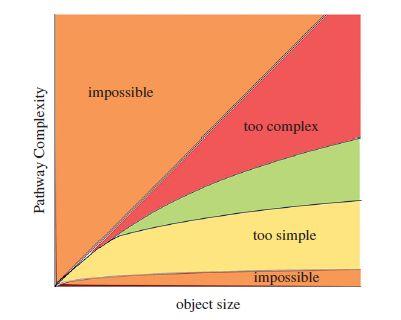
Figure 2. An illustrative graph of complexity against size of the state space. Orange regions are impossible as they are above or below the bounds of the measure. The green region is where living systems may be most probable, where structures are neither too simple to be definitively biological, nor too complex to exist at all. [4]
Cronin states? :
“We can extend the basic complexity measure above to cope with assessing the complexity of a group of objects that contain identical connection motifs (figure 5). In this case, we examine a population of objects and abstract out a common graph based on connected subunits that share features. For example, if examining a set of cups or mugs, then we can create a common graph of ‘handle connected to body’, regardless of potential variations in size/colour etc. If examining a set of human beings, then we could create a common graph of bone connectivity, ignoring variations in size/shape of individual bones, or any material in the body other than bones.”
He concludes:
“It is clear that biological and biologically derived systems have an ability to create complex structures, whether proteins or iPhones, that is not found elsewhere in nature. Assessing the complexity of such artefacts will be instrumental in searching for undiscovered biospheres, either on Earth [29] or elsewhere in the Solar System, and would make no assumptions about the details of the biology found. We propose Pathway Complexity as the natural measure of complexity for the production of artefacts. In this context, we argue that there is a critical value of Pathway Complexity above which all artefacts must be biologically derived. This approach provides a probabilistic context to extending the physical basis for life detection proposed by Lovelock [30]. In further work, we will show how this applies to a range of other systems, and propose a series of experimental approaches to the detection of objects and data that could be investigated as a possible biosignature. In the laboratory, we are interested in using this approach to develop a system that can explore the threshold between a non-living and living system. Pathway Complexity may also allow us to develop a new theory for biology. This might inform anew way to search for life in the laboratory in terms of the complex products a system produces and if they could have arisen in any abundance by chance, rather than trying to measure the intrinsic complexity of the living system itself.”
Kauffman: Self Organization Theory of Life
In 1993, Stuart Kauffman published The Origins of Order: Self Organization and Selection in Evolution [2]. I consider it a tour de force? in theoretical biology. Of relevance to this post are chapters 7 and 8 on the concept of autocatalytic sets, and the crystallization of metabolisms.
Autocatalytic sets are best thought of as a linked set of components, e,g, catalytic RNA, that can build each component from others in the set. The effect of which is to rapidly increase the RNA species included in the set. From an origin of life perspective, Kauffman showed that the probability of autocatalytic sets arising increases to unity as the number of RNA species increases. Metabolisms similarly crystalize when there are enough reactants so that a complete, self-contained metabolism can be sustained. Again, the probability of such a complete metabolism will increase as the number of reactants increase.
As Kaufmann states:
“Thus we arrive at a new point of view. The emergence of a connected metabolism as a supracritical web requires a sufficient complexity of organic molecules and a sufficient complexity of potential catalysts. At that point, such a connected web is an inevitable emergent collective property of the chemical system.”? [2] p348.
The relevance to Cronin’s work should be clear. Once a self-sustaining set of components appears, the components in that set will increase rapidly compared to others in the vast space of possible components. Cronin’s metrics, such as “pathway complexity” naturally emerge when considering the number of components compared to the possible components due to random reactions.
While Kauffman’s work is theoretical, Cronin has shown that lab experiments [5] support this basic concept. In terms of biology, they are agnostic in origin, therefore freeing us from focusing on terrestrial biology as our single sample of life, and informing us of possible biosignatures.
Biosignature Search
Sampling the compound space is not something that is likely to be possible anytime soon, if ever, using spectral analysis of [exo]planet atmospheres. Even Seager’s list of possible biosignature compounds are effectively trace compounds, and there is no way to determine whether her N-S bonds hypothesis works for an exoplanet from telescopic observations.
However, the solar system is another matter, and targets such as Mars, the plumes of Enceladus, the organics on the [sub]surface of comets, Ceres and the Europan sub-surface ocean are ripe for this sort of systems analysis using mass spectrometers and IR spectroscopy on probes to determine the mix of compounds in a physical sample.
While future telescopic observations that can image worlds directly may show up life as lush, boreal zones on exoplanets, nearer to home we may be able to sample the biological detritus of such worlds through wanderers like ‘Oumuamua that may have captured bacterial life from living worlds. If exoplanet life is largely bacterial, then probes sampling the upper atmosphere or even the surface can use this technique to determine if life exists without the difficulty of trying to cultivate bacterial colonies and observing the results. While interstellar probes that could sample such worlds are a relatively distant prospect, they are possible in the centuries to come using propulsion technologies that do not require new physics.
Conclusion
Confirmation bias involves seeing the data supporting what you are expecting. The lack of artificial objects in the heavens that is the context for the Fermi Question elicits polar views of “we are the only life” to “technological life is there, we don’t recognize it”. Similarly, the lack of unambiguous signals found by SETI results in a similar dichotomy. As we noted, the ambiguous objects in the ALH84001 meteorite that came from Mars have proponents for either proposition — life and non-life. Early searches for “missing links” in the evolution of humans that found a few bones and partial skulls also resulted in polar views of whether modern humans had evolved from an apelike ancestor or been created in his present form. We can be sure that any spectroscopic evidence of proxies for life – biosignatures – will be similarly interpreted.
So far, chemical analysis of samples in our solar system have been teasers, hinting at possible life, but no more. While a video of a living animal in a sample tube would be unambiguous (although there will no doubt be claims of “it is a hoax”), the most compelling approaches would be confirmation of DNA or proteins, preferably with no known terrestrial copies. This, however, assumes life is very similar to terrestrial life, and techniques used to find such molecules will miss life that may be very different from terrestrial life. Starting from the model that living systems are complex systems, yet not so complex as to be random, chemical analyses within the scope of that with existing analyzers may well be able to indicate life with far less ambiguity than the focus upon a few proxy molecules. In this regard, the theoretical bases described by Kaufmann and Cronin, and confirmed with experiments on terrestrial living organisms, offers perhaps the best approach for sampling probes that we can envisage in the near future, although the mass penalty of a microscope would be very much appreciated.
References
1. Petkowski J et al “Natural Products Containing a Nitrogen?Sulfur Bond” J. Nat. Prod. 2018, 81, 423?446
2. Kauffman S. “The Origin of a Connected Metabolism” ch 10, p343 in The Origins of Order, 1993
3. Domagal-Goldman S et al “Life Beyond the Solar System: Remotely Detectable Biosignatures” 2018, arXiv:1801.06714 [astro-ph.EP]
4. Cronin Lee “A probabilistic framework for identifying biosignatures using Pathway Complexity” 2017, Philos Trans A Math Phys Eng Sci. 2017 Dec 28;375(2109). pii: 20160342. doi: 10.1098/rsta.2016.0342.
5. Doran D et al “A recursive microfluidic platform to explore
the emergence of chemical evolution” 2017, ? Beilstein J Org Chem.? 2017 Aug 17;13:1702-1709. doi: 10.3762/bjoc.13.164. eCollection 2017.
6. http://en.oxforddictionaries.com/definition/life
7. http://en.wikipedia.org/wiki/Allan_Hills_84001
8. Seager, Bains and Petkowski, “Toward a List of Molecules as Potential Biosignature Gases for the Search for Life on Exoplanets and Applications to Terrestrial Biochemistry,” ? Astrobiology 16(6) (June 201), 465-485

